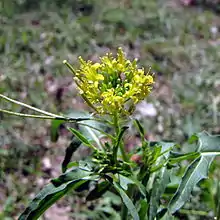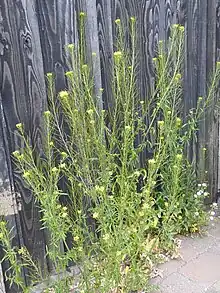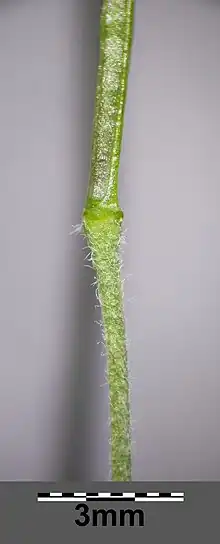Sisymbrium irio
Sisymbrium irio, London rocket, is a flowering plant in the cabbage family which is native to the Middle East, north Africa and southern Europe, and which has spread widely around the world as an invasive plant of dry, disturbed land in towns, deserts and farmland. It has traditionally been used as a medicinal herb for a variety of ailments. Its English common name originated when it flourished after the Great Fire of London in 1666, although it is not native to Britain and it does not tend to persist there.
| Sisymbrium irio | |
|---|---|
 | |
| Scientific classification | |
| Kingdom: | Plantae |
| Clade: | Tracheophytes |
| Clade: | Angiosperms |
| Clade: | Eudicots |
| Clade: | Rosids |
| Order: | Brassicales |
| Family: | Brassicaceae |
| Genus: | Sisymbrium |
| Species: | S. irio |
| Binomial name | |
| Sisymbrium irio | |
Description
London rocket is a winter annual herb which is very variable in size. It can grow to be a large, leafy plant as much as 130 cm tall in Britain,[1] but only a small, rosette-forming one about 10 cm tall in Arabia,[2] where it is native. It has an erect, usually branched stem which is green, terete, solid and almost glabrous, except for a smattering of short (0.5 mm), soft hairs. The leaves are alternate and imparipinnate or pinnatisect, up to 18 cm long, with one to five pairs of lateral lobes and a round or ternate terminal lobe. The petioles are up to 6 cm long, channelled and slightly decurrent down the stem, without stipules. They are finely hairy on both surfaces, uniformly green except for a pale midrib, and have a peppery flavour.[3][4][5]

The actinomorphic flowers are about 5 mm in diameter and are arranged in racemes of 50-100 or more at the tips of the main stem and the branches. Each flower has 4 yellow petals, 4 green, finely hairy sepals which are nearly as long as the petals, and 6 stamens. The flower stalks (pedicels) are short at flowering time, creating a rather flat-topped and crowded inflorescence, but they elongate as the fruits develop, soon causing them to overtop the flowers. The fruit is a long (3-8 cm) narrow cylindrical silique which stays green when ripe and is slightly torulose (i.e. with lumps where the seeds occur, like a string of beads), and they are held at a divergent angle to the stem on the long, thin, hairy pedicels. When dried the fruit contains one row of small (ca. 1 mm) red oblong seeds in each of the two valves of the silique, amounting to about 100 seeds in each pod. A single plant can therefore produce many tens of thousands of seeds in total.[1][6]
Identification

London rocket can easily be confused with other species of Sisymbrium. Characters to look for include the compact flower head, the way the developing seedpods extend above the flowers, and the long, thin pedicels which are narrower than the fruits.[1]
Taxonomy
The name Sisymbrium irio was coined by Linnaeus in 1753, in his book Species Plantarum (vol. 2, p. 659). Since then it has accumulated many synonyms, including Phryne laxata (by Pietro Bubani in 1901) and Arabis charbonnelii (by Augustin Léveillé in 1913), but the original name is still accepted as the correct one. A full list of synonyms is given in the Update on the Brassicaceae Species Checklist.[7]
Several subspecies and varieties have also been named over the years, but again none is currently accepted.[8]
The chromosome number of London rocket is a complex subject. The diploid has 14 chromosomes (2n = 14), but there are triploid, tetraploid, hexaploid and octoploid "races" with 21, 28, 42 and 56 chromosomes, respectively. These races have different phenotypes and ecological adaptations, and they vary in their fertility, with the triploid being almost entirely sterile.[9]
Distribution and status
London rocket is thought to be native in the Middle East and as far eastward as NW India or Mongolia, and westward throughout North Africa and southern Europe. It has been introduced to North America, where it is considered something of a pest species in the southern US and Mexico, and to South America, Australasia and southern Africa. It has also spread as far east as Korea and Japan.[8][7][6]
Its status internationally has not been evaluated, but it is not considered to be at risk in most countries in which it occurs, as is classified as Least Concern.[10]
London rocket was introduced to Britain by the 1650s and has maintained a scattered distribution since then. It does not tend to persist in any site for long, and is even believed to have disappeared from London by the late 19th century, only to be reintroduced again in the 20th. It comes in via docks and other transport hubs, and it used to turn up in fields that had been treated with wool shoddy. Overall, the population has remained more or less stable for centuries, although its transient nature means there are many more places where it used to occur than there are at any one time, leading to the mistaken impression that it is perpetually declining.[11][12]
One country where it has recently arrived is Korea, where it has been studied very closely. The point of arrival was the port of Busan, from where it spread 1.5 km along a roadside over a 10 year period. It is currently considered to be established but not invasive.[6]
Habitat and ecology
The Database of Insects and their Food Plants lists just two species that make use of London rocket: Ceutorhynchus hirtulus Germar is a weevil which lives in the soil and creates stem galls for it larvae,[13] whereas Cabbage looper moth larvae eat the leaves of this and many other species in the cabbage family.
History
The first published record of this species in Britain was in Christopher Merret's Pinax Rerum Naturalium Britannicarum in 1666, where he described Irio laevis as being "ubique fere in suburbiis Lond. supra muros et juxta fossas" (almost everywhere in the suburbs of London on walls and near ditches).[14][15] It had, however, been noticed at least a decade earlier: William How (1620-1656) had annotated his own copy of his book Phytologia Britannica (1650) with the comment "near White Chappel east from Aldgate, London"; a discovery he attributed to John Goodyer.[11]
The term "London" in the common name "London rocket" allegedly comes from its abundance after the Great Fire of London in 1666.[16][17] Robert Morison, the physician to King Charles II, attributed their appearance to spontaneous generation when he observed that “these hot bitter plants with four petals and pods were produced spontaneously without seed by the ashes of the fire mixed with salt and lime.”[18]
In contrast, Dr E J Salisbury, in his study of the bombsites of London after the Blitz in 1940, "failed to find a single specimen, nor has any other reliable observer reported it."[19][20] This is consistent with its apparent appearance, disappearance, and reappearance described above at "Distribution and Status."
The term "Rocket" in the common name appears to be derived from the old Latin term "eruca" applied to several loosely-related plants in the cabbage family. [Mabey, Richard. "Weeds: In Defense of Nature's Most Unloved Plants." Chapter 10. HarperCollins Publishers, 2010]
This species is considered a weed in the Southwestern United States and other regions where it has been introduced.[21]
Uses
In desert regions of Arabia and Egypt, London rocket is considered an important source of fodder for livestock.[22]
The leaves, seeds, and flowers are edible to humans, with a spicy flavor similar to cultivated rocket.[23] London rocket is used in the Middle East to treat coughs and chest congestion, to relieve rheumatism, to detoxify the liver and spleen, and to reduce swelling and clean wounds.[24]
The Bedouin of the Sinai Peninsula and the Negev desert reportedly used the leaf of London rocket as a tobacco substitute, and a recent study of the alkaloid content of desert-grown plants in Iraq found a high concentration of nicotine in extracts of the aerial parts of this plant.[25][26]
The cured pods can be placed in a basket with live coals and shaken until the pods are parched, then ground into meal and made into soup or stew.[27]
Notes
- Sell, P.D.; Murrell, G. (2014). Flora of Great Britain and Ireland, vol. 2. Cambridge: Cambridge University Press. ISBN 978-0-521-55336-0.
- Collenette, Sheila (1985). An Illustrated Guide to the Flowers of Saudi Arabia. London: Scorpion Publishing. ISBN 0-905906-45-4.
- Stace, C.A. (2019). New Flora of the British Isles. Suffolk. ISBN 978-1-5272-2630-2.
{{cite book}}: CS1 maint: location missing publisher (link) - Rose, Francis (2006). The Wild Flower Key. London: Frederick Warne. ISBN 978-0-7232-5175-0.
- Poland, John; Clement, Eric (2009). The Vegetative Key to the British Flora. Southampton: John Poland. ISBN 978-0-9560144-0-5.
- Kim, Hye-Won; Choi, Tae-Young; Son, Dong Chan; Jo, Hyeryun; Lee, Soo-Rang (2021). "Sisymbrium irio L. (Brassicaceae): a new alien plant in Korea". BioInvasions Records. 10 (2): 453–466. doi:10.3391/bir.2021.10.2.23.
- Global Biodiversity Information Facility. "Sisymbrium irio L." Retrieved 20 April 2023.
- Plants of the World Online. "Sisymbrium irio L." Retrieved 20 April 2023.
- Khoshoo, T.N. (1960). "Biosystematics of Sisymbrium irio complex, IX: Genome analysis" (PDF). J. Indian Bot. Soc. 39: 217–226.
- European Nature Information System. "Sisymbrium irio L." Retrieved 20 April 2023.
- Swindells, John (2006). Sisymbrium irio L. (London-rocket): its status in Britain and Ireland. University of Birmingham: Masters dissertation.
- Preston, C.D.; Pearman, D.A.; Dines, T.D. (2002). New Atlas of the British and Irish Flora. Oxford: Oxford University Press.
- Plant Parasites of Europe. "Ceutorhynchus hirtulus Germar, 1824". Retrieved 23 April 2023.
- Merrett, Cristopher (1666). Pinax Rerum Naturalium Britannicarum. London. p. 66.
- Clarke, W.A. (1900). First Records of British Flowering Plants. London: West, Newman & Co.
- A.R. Clapham; E.F. Warburg; T.G. Tutin (1968). Flora of the British Isles. Cambridge University Press. ISBN 9780521046565.
- Kidd, Beth (March 30, 2023). "Plant of the Month: London Rocket". JSTOR Daily. Retrieved April 7, 2023.
- Mabey, Richard (June 28, 2011). "Chapter 10 French Willow". Weeds: In Defence of Nature's Most Unloved Plants. Ecco Press. ISBN 978-0062065452.
- Fitter, R. S. R. (1945). London's Natural History. London: Collins. p. 231. ISBN 1-870630-69-6.
- The Ecology of Transportation, p. 11, at Google Books
- Hennessy-Fiske, Molly (2019-03-11). "Naturalists scour border to draw attention to habitat, not migrant crisis". Los Angeles Times. Retrieved 2019-03-12.
- Shehata, H.F.S. (2014). "Ecology and nutritive status of Sisymbrium irio L. in the Nile Delta, Egypt" (PDF). Egypt. J. Exp. Biol. (Bot.). 10 (2): 127–142.
- "edible weeds | Savor the Southwest". savorthesouthwest.blog. 14 February 2014. Retrieved 2018-11-18.
- Lev, Efraima (2003) "Sisymbrium irio" Medicinal substances in Jerusalem from early times to the present day Archaeopress, Oxford, UK, p. 62, ISBN 978-1-84171-490-5
- Bailey, C.; Danin, A. (1981). "Bedouin Plant Utilization in Sinai and the Negev". Economic Botany. 35 (2): 145–162. doi:10.1007/BF02858682. JSTOR 4254272. S2CID 27839209.
- Alsaffar, A.F; Abbas, I.S.; Dawood, A.H. (2016). "Investigation of the Main Alkaloid of London Rocket (Sisymbrium irio L) as a Wild Medicinal Plant Grown in Iraq". Int. J. Pharm. Sci. Rev. Res. 39 (1): 279–281.
- Warnock, Barton H. (1977) "Wildflowers of the Davis Mountains and the Marathon Basin, Texas", p. 111
References
- Everitt, J.H.; Lonard, R.L.; Little, C.R. (2007). Weeds in South Texas and Northern Mexico. Lubbock: Texas Tech University Press. ISBN 0-89672-614-2
- Ray, Jarren et al. (2005) "Moisture and Temperature Requirements for London Rocket (Sisymbrium irio) Emergence" Weed Science 53(2): pp. 187–192
- Fitter, R. S. R. (1945). London's Natural History. London: Collins. p. 231. ISBN 1-870630-69-6.
